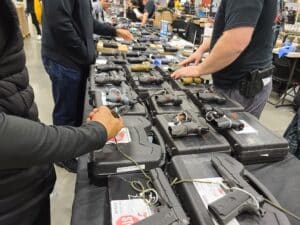Election day is nearly here.
Vice President Kamala Harris and Former President Donald Trump are locked in a close presidential race. One of them will most certainly win. Here’s a look at what to expect in either direction.
First, it’s key to set expectations for what the makeup of the federal government is likely to be. Not certainly, but likely.
Only a third of the Senate is up for election each year. Our politics are severely polarized, which limits how often candidates from the party that didn’t win a state’s presidential race are able to win its Senate race. So, the map of Senate seats up for election tells us a lot about the likely outcome.
This year, Republicans have a big advantage. The Senate is starting at a 50-50 split, and there are far more Democratic seats up for grabs in red or purple states than vice versa. It would take an abysmal performance for Republicans not to control the Senate after Tuesday.
Then there’s the House of Representatives. That, too, is currently at a nearly even split. It’s likely the winning presidential candidate will boost enough House candidates in their party to grab control of the House.
That doesn’t necessarily matter a whole lot when it comes to gun legislation, though. While a Trump win probably means full Republican control of the federal government, but only by slim margins. Those slim margins would probably prevent them from being able to pass substantial pro-gun legislation, such as national gun-carry permit reciprocity or silencer deregulation.
However, even slim majorities would give the GOP the ability to shape the spending and priorities of federal agencies like the ATF using budgeting measures that are already exempt from the filibuster.
On the flip side, a Harris presidency would probably have to contend with a Republican Senate majority. That almost certainly means none of the policy proposals she’s running on will come to fruition, at least until after the next election. Her policy platform of universal background checks, a “red flag” law, and an “assault weapons” ban won’t make it to a vote in a Republican-controlled Senate under anything like normal circumstances.
Even if Democrats maintained control of the Senate under a Harris Administration, they too would probably have a tough time finding 60 votes to pass any of their most substantial gun restrictions. The wild card in these calculations is, of course, whether one side nukes the legislative filibuster and knocks the vote threshold down to 50. Harris and Trump have both supported nuking the filibuster at various points, but each party’s Senate caucus has opposed the idea to this point. But it’s not impossible single-party control of DC could lead to the end of the filibuster, which would upend all of these predictions.
Still, the best bet for action on guns is likely to come from what the President has direct power over.
Appointing judges will be one of the longest-lasting ways Harris or Trump can have a direct impact. That’s another area where Trump would have more leeway if the Senate goes the way people expect. Judge appointments are also the area he had the strongest pro-gun accomplishments in his first term, appointing three of the Supreme Court Justices in the majority for the landmark New York State Rifle and Pistol Association v. Bruen decision.
Harris would likely continue a similar trajectory with judicial appointments as Biden, whose only Supreme Court appointee has been severely critical of the Court’s Second Amendment jurisprudence. However, she may be forced to moderate her judicial picks in order to get them through a Republican-controlled Senate. She may even face total resistance to more important appointments, as has become increasingly common in recent years.
The one area Trump or Harris wouldn’t have to worry about Congressional approval is executive action.
Trump has said he’ll fire the permanent ATF Director Biden appointed. Although, he hasn’t said who he’d replace him with and his previous nominee was rejected by his own party during his first term. He’s also promised to undo all of the rules Biden has imposed through the ATF, including the pistol brace and “ghost gun” bans. He hasn’t promised much in the way of his own rulemaking, though, and his only effort on that front during his first term was the bump stock ban his own Supreme Court appointees found unconstitutional earlier this year.
Harris would keep Biden’s ATF rules in place, though the courts may strike them down. She’ll likely try to expand on them in some way as well. But she hasn’t laid out any proposals yet, and Biden has already gone into the most obvious grey areas in federal gun law.
So, barring a radical change to either our government or our gun politics, Trump and Harris will face high hurdles to pass significant legislative reforms. But that doesn’t mean they couldn’t have a significant impact on American gun policy. Although, the likely makeup of the Senate and recent federal rulemaking gives Trump an upper hand in the potential for exercising executive power.






